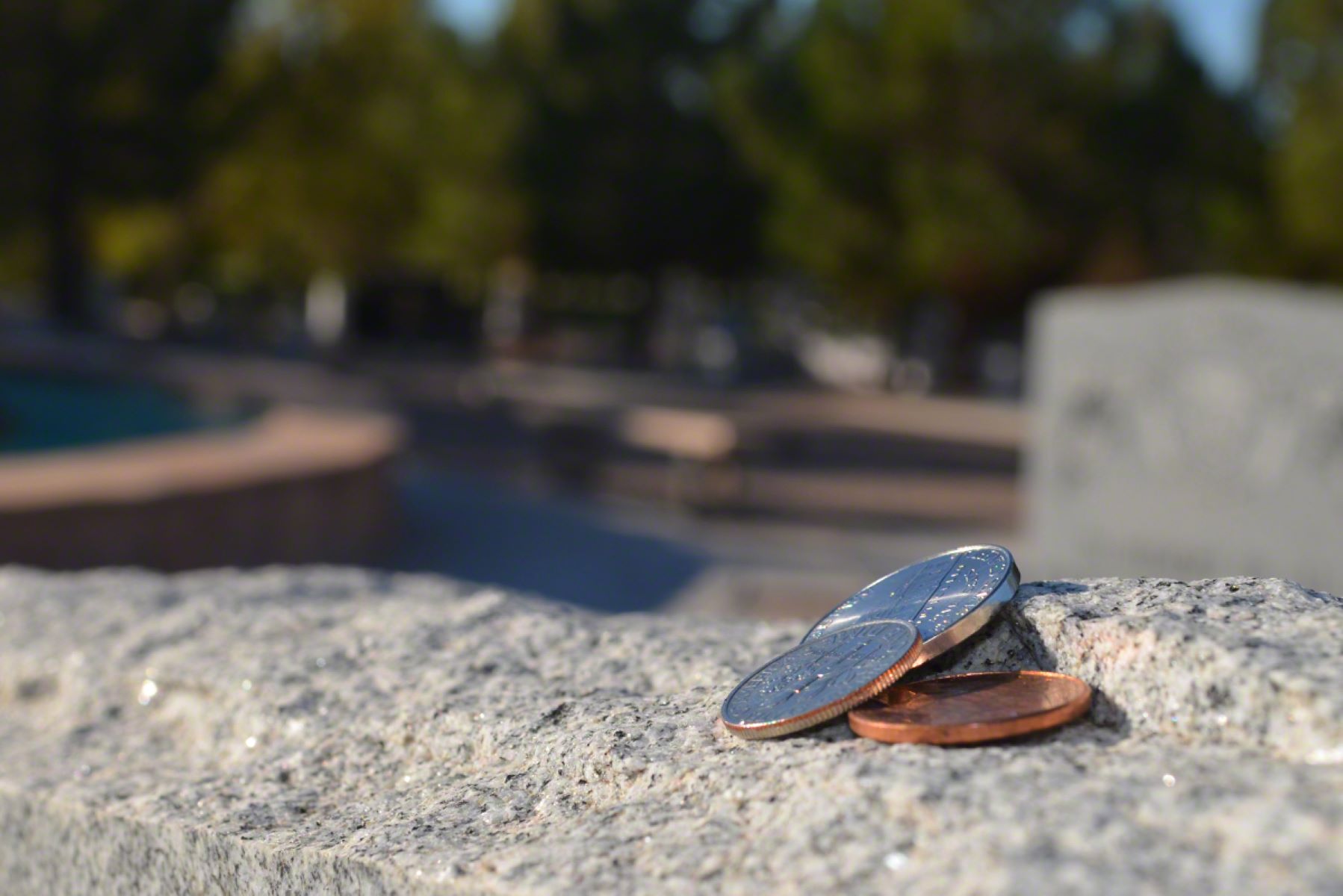Home>Arts and Culture>The Surprising Reason People Place Pennies On Graves


Arts and Culture
The Surprising Reason People Place Pennies On Graves
Published: February 15, 2024
Discover the tradition of placing pennies on graves and the cultural significance behind this practice. Explore the intersection of arts and culture in this unique and surprising ritual.
(Many of the links in this article redirect to a specific reviewed product. Your purchase of these products through affiliate links helps to generate commission for Regretless.com, at no extra cost. Learn more)
Table of Contents
Introduction
Have you ever wandered through a cemetery and noticed shiny pennies resting atop gravestones? This seemingly peculiar sight often sparks curiosity and prompts one to ponder the significance behind it. The tradition of placing pennies on graves is a practice deeply rooted in history, culture, and human emotion. While it may appear enigmatic at first glance, delving into its origins and meanings reveals a fascinating tapestry of customs, beliefs, and sentiments.
The act of leaving pennies on graves is not merely a random gesture, but rather a poignant expression of respect, remembrance, and honor. It serves as a tangible symbol of connection between the living and the departed, transcending time and space. As we unravel the layers of this tradition, we will uncover its historical roots, cultural and religious significance, modern interpretations, and the profound psychological and emotional motivations that underpin this age-old custom. Join me on this exploration as we unravel the surprising reasons behind why people place pennies on graves.
Historical Origins of the Tradition
The tradition of placing pennies on graves has a rich and storied history that dates back centuries. Its origins can be traced to various cultural and historical contexts, each imbued with unique significance and symbolism.
One compelling origin of this tradition can be found in ancient Greek mythology. According to legend, a coin was placed in the mouth of the deceased as payment for Charon, the ferryman who transported souls across the river Styx to the afterlife. This practice was believed to ensure safe passage for the departed into the realm of the dead. Over time, the act of leaving coins on graves evolved from a practical ritual into a symbolic gesture of farewell and goodwill.
In the context of military tradition, the placement of coins on gravestones has a poignant history. During the Vietnam War, soldiers started leaving coins as a way to communicate with fallen comrades. Each type of coin held a specific meaning: a penny indicated a simple visit, a nickel signified that the visitor and the deceased trained at boot camp together, a dime symbolized that they served in the same company, and a quarter conveyed the deepest respect, indicating that the visitor was present when the fallen soldier passed away. This tradition of leaving coins as a form of communication and tribute continues to be honored by military personnel and their families.
Furthermore, the tradition of leaving coins on graves has been associated with the concept of paying one's respects. In some cultures, placing coins on a grave is a gesture of ensuring that the deceased will never be forgotten. The act of leaving a coin can be seen as a small token of remembrance, a way to signify that the individual's memory lives on in the hearts of those who visit the grave.
As we delve into the historical origins of this tradition, it becomes evident that the practice of leaving pennies on graves has evolved through a tapestry of cultural, religious, and historical influences. Each iteration of this tradition reflects a profound connection between the living and the departed, weaving a narrative of remembrance and reverence that transcends time and borders.
Cultural and Religious Significance
The tradition of placing pennies on graves carries profound cultural and religious significance, resonating with diverse belief systems and customs across the world. In many cultures, the act of leaving coins at gravesites is steeped in symbolic meaning and serves as a tangible expression of respect, remembrance, and spiritual connection.
Within the realm of religious traditions, the placement of coins on graves often reflects deeply held beliefs about the afterlife and the enduring bond between the living and the departed. In some religious contexts, such as Christianity, the act of leaving coins can be interpreted as a gesture of charity and kindness, reflecting the teachings of compassion and generosity. It symbolizes a form of almsgiving, an act of goodwill extended to the deceased as a means of honoring their memory and seeking spiritual blessings for their soul.
Moreover, the cultural significance of leaving coins on graves extends beyond religious frameworks, encompassing a tapestry of customs and beliefs. In certain societies, the practice of adorning graves with coins is rooted in the concept of providing sustenance for the departed in the afterlife. It is believed that the coins left on graves serve as a form of currency that enables the deceased to navigate the spiritual realm, ensuring their well-being and prosperity in the next life.
Additionally, the act of placing pennies on graves holds cultural significance as a gesture of remembrance and solidarity. It symbolizes a timeless connection between the living and the deceased, emphasizing the enduring impact of an individual's life on those they leave behind. This act of commemoration transcends cultural boundaries, serving as a universal expression of honor and reverence for the departed.
The cultural and religious significance of leaving pennies on graves underscores the enduring power of ritual and symbolism in human experience. It reflects a profound interconnectedness between the realms of the living and the dead, weaving a narrative of remembrance, compassion, and spiritual continuity across diverse cultural and religious landscapes. As we continue to explore the multifaceted meanings of this tradition, we gain deeper insights into the rich tapestry of human beliefs and customs that shape our understanding of life, death, and the enduring legacy of those who have passed on.
Modern Interpretations and Practices
In contemporary society, the tradition of placing pennies on graves has evolved to encompass a diverse array of interpretations and practices, reflecting the shifting landscape of cultural norms, personal expressions of remembrance, and evolving attitudes towards death and commemoration. While rooted in historical and religious traditions, modern interpretations of this custom reflect a blend of timeless symbolism and contemporary sensibilities.
One modern interpretation of the practice involves the concept of memorialization and personal connection. For many individuals, leaving a penny on a loved one's grave serves as a tangible expression of remembrance and a way to maintain a sense of connection with the departed. In a fast-paced world marked by constant change, the act of visiting a grave and leaving a small token such as a penny can provide a moment of quiet reflection and an opportunity to honor the memory of a cherished individual.
Furthermore, the tradition of placing pennies on graves has found resonance in the realm of collective remembrance and social solidarity. In the context of military cemeteries and memorials, the act of leaving coins has taken on added significance as a communal expression of gratitude and respect for fallen soldiers. Visitors leave pennies as a gesture of appreciation for the sacrifices made by those who served their country, symbolizing a collective commitment to honoring the legacy of the fallen.
In a broader societal context, the practice of leaving pennies on graves has also become intertwined with the concept of meaningful tributes and acts of kindness. Individuals from all walks of life, regardless of cultural or religious background, may choose to leave a penny on a grave as a gesture of empathy and solidarity with the deceased and their loved ones. This act transcends personal connections, serving as a universal symbol of compassion and respect for the departed.
Moreover, the digital age has brought new dimensions to the tradition of leaving pennies on graves. Online platforms and social media have provided avenues for individuals to share stories and photos of pennies left on graves, fostering a sense of interconnectedness and allowing people to pay tribute to individuals they may never have met. This digital extension of the tradition reflects the enduring power of remembrance in an increasingly interconnected world.
As we navigate the complexities of modern life, the tradition of leaving pennies on graves continues to evolve, reflecting a blend of timeless symbolism and contemporary expressions of remembrance. Whether as a personal gesture of connection, a communal act of gratitude, or a universal symbol of compassion, the practice of placing pennies on graves serves as a poignant reminder of the enduring legacy of those who have passed on and the timeless bonds that connect the living and the departed.
Psychological and Emotional Motivations
The tradition of placing pennies on graves is deeply intertwined with profound psychological and emotional motivations that underpin this age-old custom. At its core, this practice reflects a complex tapestry of human emotions, beliefs, and coping mechanisms in the face of loss and mortality.
One of the key psychological motivations behind the act of leaving pennies on graves is the innate human need for connection and remembrance. Grief and loss often evoke a longing to maintain a sense of closeness with the departed, and the act of leaving a penny can serve as a tangible manifestation of this yearning for connection. It provides individuals with a physical means of expressing their enduring bond with the deceased, offering a sense of comfort and continuity in the face of loss.
Moreover, the practice of placing pennies on graves can also be viewed through the lens of coping and healing. For many individuals, the act of visiting a grave and leaving a penny serves as a form of ritualized remembrance that contributes to the process of grieving and healing. It provides a structured outlet for processing emotions and paying tribute to the departed, offering a sense of solace and closure in the midst of mourning.
Additionally, the act of leaving a penny on a grave can be a deeply personal and introspective gesture, reflecting an individual's unique emotional journey. It can serve as a means of expressing gratitude, seeking forgiveness, or simply acknowledging the enduring impact of the deceased on one's life. This deeply personal aspect of the tradition underscores the multifaceted nature of human emotions and the diverse ways in which individuals navigate the complexities of loss and remembrance.
From a psychological perspective, the tradition of leaving pennies on graves embodies a profound intertwining of grief, remembrance, and the human quest for meaning in the face of mortality. It reflects the enduring power of ritual and symbolism as mechanisms for processing emotions and honoring the legacies of those who have passed on. This practice serves as a poignant reminder of the depth and resilience of the human spirit in the face of loss, weaving a narrative of remembrance and emotional connection that transcends time and space.
Conclusion
In conclusion, the tradition of placing pennies on graves is a profound and multifaceted practice that transcends time, culture, and belief systems. From its rich historical origins rooted in ancient mythology and military tradition to its enduring cultural and religious significance, this age-old custom reflects the enduring power of remembrance, connection, and compassion. As we navigate the complexities of modern interpretations and the profound psychological and emotional motivations that underpin this tradition, it becomes evident that the act of leaving pennies on graves is a poignant reflection of the human experience in the face of loss and mortality.
This tradition serves as a tangible bridge between the realms of the living and the departed, embodying a timeless expression of respect, honor, and solidarity. Whether as a gesture of personal remembrance, a communal act of tribute, or a universal symbol of compassion, the placement of pennies on graves underscores the enduring legacy of those who have passed on and the indelible impact they have left on the lives of others. It reflects the human quest for connection, meaning, and healing in the face of grief, weaving a narrative of remembrance that resonates across diverse cultural, religious, and societal landscapes.
As we contemplate the surprising reasons behind why people place pennies on graves, we are reminded of the enduring bonds that connect us to the past and the profound impact of ritual and symbolism in shaping our understanding of life, death, and the human experience. This tradition serves as a poignant reminder of the depth and resilience of the human spirit in the face of loss, offering a timeless testament to the enduring power of remembrance and the enduring legacy of those who have passed on.














